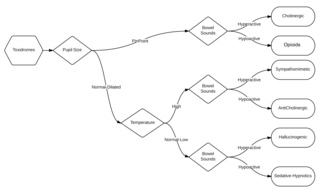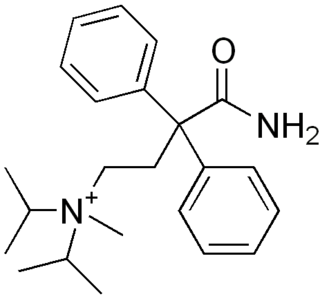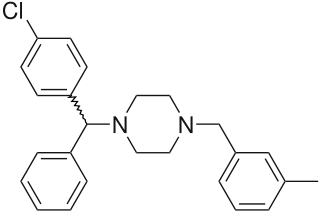
Benzatropine, also spelled benztropine, is a medication used to treat a type of movement disorder due to antipsychotics known as dystonia and parkinsonism. It is not useful for tardive dyskinesia. It is taken by mouth or by injection into a vein or muscle. Benefits are seen within two hours and last for up to ten hours.
Anticholinergic is a group of substances that blocks the action of the neurotransmitter acetylcholine (ACh) at synapses in the central and the peripheral nervous system, and, in broad terms, neuromuscular junction.

Brompheniramine, sold under the brand name Dimetapp among others, is an antihistamine drug of the propylamine (alkylamine) class. It is readily available over the counter and is indicated for the treatment of the symptoms of the common cold and allergic rhinitis, such as runny nose, itchy eyes, watery eyes, and sneezing. It is a first-generation antihistamine and one of the drugs of highest anticholinergic activity.

Ipratropium bromide, sold under the trade name Atrovent among others, is a medication which opens up the medium and large airways in the lungs. It is used to treat the symptoms of chronic obstructive pulmonary disease and asthma. It is used by inhaler or nebulizer. Onset of action is typically within 15 to 30 minutes and lasts for three to five hours.

A toxidrome is a syndrome caused by a dangerous level of toxins in the body. The term was coined in 1970 by Mofenson and Greensher. It is often the consequence of a drug overdose. Common symptoms include dizziness, disorientation, nausea, vomiting, and oscillopsia. A toxidrome may indicate a medical emergency requiring treatment at a poison control center. Aside from poisoning, a systemic infection may also lead to a toxidrome. "Classic" toxidromes are presented below, but they are often variable or obscured by the co-ingestion of multiple drugs.
Diphenoxylate/atropine, also known as co-phenotrope, is a combination of the medications diphenoxylate and atropine, used to treat diarrhea. It should not be used in those in whom Clostridioides difficile infection is a concern. It is taken by mouth. Onset is typically within an hour.

Deliriants are a class of hallucinogen. The term was introduced by David F. Duncan and Robert S. Gold to distinguish these drugs from psychedelics and dissociatives, such as LSD and ketamine respectively, due to their primary effect of causing delirium, as opposed to the more lucid states produced by such other hallucinogens as are represented by psychedelics and dissociatives. The term is generally used to refer to anticholinergic drugs which are substances that inhibit the function of the neurotransmitter acetylcholine. Typical or common examples of deliriants include Datura as well as higher than recommended dosages of Diphenhydramine.

Orphenadrine is an anticholinergic drug of the ethanolamine antihistamine class; it is closely related to diphenhydramine. It is used to treat muscle pain and to help with motor control in Parkinson's disease, but has largely been superseded by newer drugs. This substance is considered a dirty drug due to its multiple mechanism of action in different pathways. It was discovered and developed in the 1940s.

Trihexyphenidyl, also known as benzhexol and trihex, is an antiparkinsonian agent of the antimuscarinic class. It has been in medical use for decades.

Oxybutynin, sold as under the brand names Ditropan among others, is a medication used to treat overactive bladder. It works similar to tolterodine. While used for bed wetting in children, evidence to support this use is poor. It is taken by mouth or applied to the skin.

Methyl vinyl ketone (MVK, IUPAC name: butenone) is the organic compound with the formula CH3C(O)CH=CH2. It is a reactive compound classified as an enone, in fact the simplest example thereof. It is a colorless, flammable, highly toxic liquid with a pungent odor. It is soluble in water and polar organic solvents. It is a useful intermediate in the synthesis of other compounds.

Procyclidine is an anticholinergic drug principally used for the treatment of drug-induced parkinsonism, akathisia and acute dystonia; Parkinson disease; and idiopathic or secondary dystonia.

Trospium chloride is used to treat overactive bladder.

Pridinol is a muscle relaxant that is used as an antiparkinsonian and anticholinergic drug.

Isopropamide (R5) is a long-acting anticholinergic drug. It is used in the treatment of peptic ulcers and other gastrointestinal disorders involving hyperacidity and hypermotility. Chemically, it contains a quaternary ammonium group. It is most often provided as an iodide salt, but is also available as a bromide or chloride salt. It was discovered at Janssen Pharmaceutica in 1954.

Nystagmus is a condition of involuntary eye movement, acquired in infancy or later in life, that may result in reduced or limited vision. Due to the involuntary movement of the eye, it has been called "dancing eyes".

Meclizine, sold under the brand names Bonine among others, is an antihistamine used to treat motion sickness and the feeling like the world is spinning (vertigo). It is taken by mouth. Effects generally begin in an hour and last for up to a day.

Oxitropium bromide is an anticholinergic used as a bronchodilator for the treatment of asthma and chronic obstructive pulmonary disease.
Peripherally selective drugs have their primary mechanism of action outside of the central nervous system (CNS), usually because they are excluded from the CNS by the blood-brain barrier. By being excluded from the CNS, drugs may act on the rest of the body without producing side-effects related to their effects on the brain or spinal cord. For example, most opiates cause sedation when given at a sufficiently high dose, but peripherally selective opiates can act on the rest of the body without entering the brain and are less likely to cause sedation.

Field sobriety tests (FSTs), also referred to as standardized field sobriety tests (SFSTs), are a battery of tests used by police officers to determine if a person suspected of impaired driving is intoxicated with alcohol or other drugs. FSTs are primarily used in the US, to meet "probable cause for arrest" requirements, necessary to sustain an alcohol-impaired driving conviction based on a chemical blood alcohol test.

















